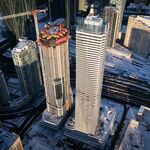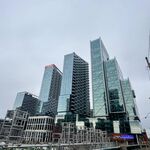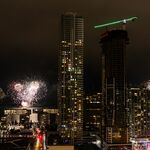ARG1
Senior Member
My general thought process comes down to a few major ideas.So, I haven't drawn any conclusions as I type this first line; but I will look at the map, to see if I can discern why the stops you note above were inserted, and what impact, if any, is obvious.
Stevenson:
Chosen likely for 3 factors, the mall to the south, but this, as noted prior is served by 2 other stops.
But the stop also directly serves these 2 residential towers:
View attachment 541302
It also serves a Junior High just up the street that is ~290M from Finch.
So the impact of removing the stop is taking the distance for the residential ~ 25M and the Junior High and considering the distance w/o that stop.
Distance to Kipling : ~710M (school); 430M for apartments.
Distance to Albion: ~560M (school); 332M for apartments.
***
I think there's a reasonable case for removal here, the primary impact is on the middle school which is material, but likely represents a fairly low portion of any potential ridership.
****************
Now lets' look at Driftwood:
Serves the east end of the Jane Finch Mall.
The only significant density currently is San Romanoiway which is under 300M to the Jane-Finch intersection.
There is the vast proposed densification of the Jane-Finch Mall site to consider here; where I would note, I have proposed moving Driftwood closer to Jane, which definitively remove any justification for a stop.
The only knocks on removal here are:
Removes a connecting bus route and stop, creating a walking transfer.
Also, with future density, I don't believe the current platform design at Jane would carry sufficient capacity. (there is, however, room, for now, to widen those platforms, albeit with some expensive changes to curbs/roads/streetscape etc.
*******
I think I'll leave it there for now.
1) Is there a connection to a major/important bus route? This is why I'm fine with having the Kipling, Albion, and Martin Grove Stations despite being in relatively close proximity because all 3 of those streets are connections to major bus routes.
2) If there isn't a connection to a major bus route, is there a connection to a high demand commercial destination? This is why stations like Milvan-Rumike work.
3) If the station would only serve residential areas, how far would they have to walk to reach the next station if it didn't exist, and what are those walking conditions (walking under a highway, etc.). The reason I'm fine with having either Pearldale or Duncanwoods is because they both act as a sort of center for the surrounding subdivisions outside of Islington itself, and you could have community bus routes joining to it.
The one question I have to you is what is the transit modeshare for that junior high? Do grade 7s and 8s really take public transit that often because I typically I associate transit use with full on high school students.
This is a bit extreme. Honestly if we were to up the budget to allow ourselves 1 more tunneled segment/station, the one change I'd make is to actually tunnel the line underneath Albion Mall. This would allow for a direct weather protected connection to the mall, and allow direct transfers to 2 major bus routes (with a possible bus terminal), whilst also cutting down 3 separate stops into 1, and finally reducing the overall line length. This could have huge end to end time saving ramifications for everyone other than the students at that junior high.If we had unlimited money there could have been a better way to design the Finch West LRT which would have improved speed but still serve the local community.
1. LRT should have resurfaced after passing Romfield Lane. It would allow the LRT to bypass traffic lights and avoid unnecessary delays. From here the LRT would run surface level to serve the local community,
View attachment 541423
2. The next big and expensive change would be to remove the Driftwood Ave stop and bury the Finch West LRT between Jane and Weston. The LRT could have entered a trench before driftwood to avoid that traffic light. My logic here is Finch West during rush hour is packed with cars and having the train run surface level here increases the chances of delays due to traffic and accidents. If the LRT ran unground in this section the trains could travel fast. The stops would remain the same with stops at Jane, Norfinch/ Oakdale, Signet/ Arrow, and Weston. The LRT could have resurfaced after passing Jayzel Dr, avoiding another traffic light, and run surface level to serve the local community.
View attachment 541427
3. Now for a smaller change I would have removed the stop at Duncunwoods Dr.
4. After passing through Pearldale Ave. the LRT could have gone through an above-ground section with an above-ground station at Islington. Between Islington and Kipling the lrt would run along the surface
View attachment 541428
4. lastly the LRT would go below grade between Kipling and Albion to avoid those busy intersections. It could have been built similarly to the Mississauga Transitway to keep costs down. Also, Stevenson station would be removed. After Albion, the LRT would resurface and run above ground.
View attachment 541429
*************************
My logic overall is the LRT would run separately at busy intersections, but serve more local trips between the major intersections. You would get both speed and convenience. hopefully satisfying both parties in this debate.





